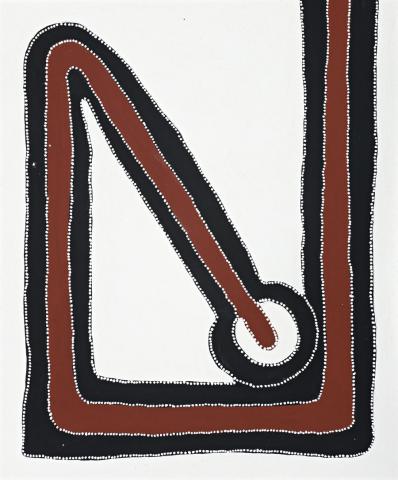MENDOOWOORRJI - MEDICINE POCKET, 2000
PADDY BEDFORD
natural earth pigments and synthetic binder on linen
180.0 x 150.0 cm
initialled verso: PB
inscribed verso: Jirrawun Aboriginal Arts cat. PB 3 2000.64
Jirrawun Aboriginal Arts, Kununurra
William Mora Galleries, Melbourne (stamped verso)
Private collection, Melbourne
Storer, R., Paddy Bedford, Museum of Contemporary Art, Sydney, 2006, pp. 83, 147 (illus.)
According to Tony Oliver, former CEO of the Jirrawun Aboriginal Art Corporation, Paddy Bedford’s experience of painting had strong foundations in his close friendships with artists Paddy Jaminji, Hector Jandany and Rover Thomas whose canvases he helped to prepare and whose progress he quietly observed. It was only after these pioneers of the Kimberley movement had died that Bedford first began to paint, taking on the responsibility of producing ceremonial boards. These initial works were executed with a remarkable confidence that reflects his authority and importance as a traditional elder. The rest is legend, as within several years Bedford acquired a reputation for not only inheriting the legacy of Rover Thomas but of pushing new boundaries with his famously fluent “walking line”.1
Paddy Bedford carried further the manner and sparseness that characterised the east Kimberley school. His initial medium of natural ochres used to depict bold forms outlined with linear dotting echoes the early work of Rover Thomas and Freddie Timms. As his work evolved and as his canvases became increasingly sparse, Bedford replaced ochres with a simplified palette often using only black and white, or black, white and a reddish brown colour, as used in this work.
Mendoowoorrji - Medicine Pocket is catalogued as number 64 in Bedford’s chronological index of paintings. As one of only ten large scale works produced by Bedford in the year2000, its significance is also amplified by the major stylistic shifts that took place in his paintings that year. Included in his second solo show titled Selected Recent Works 2000 (William Mora Gallery), it was one of four large scale paintings exhibited. The work depicts the country of Mendoowoorrji, located to the south east of Bedford Downs. Mendoowoorrji is the general name given to the line of hills running between Thoonbi (the Ord River) and Thoowoonggoonarri (Tunganary Gorge). Medicine Pocket is a ngarranggarni place with ‘living water’, and was an important camping area before the arrival of Europeans. The site is characterised by creeks and watercourses running in open land with rocky outcrops flanked by a line of hills. This area is associated with the Wanggarnaban, the dreaming place of Wanggarnal the Crow, who camped here when she was a woman in the dreamtime. The region also has strong connections for Bedford’s mother and uncles and is part of his mothers dreaming, where two men hit each other with sticks and became part of the country.
A transcript of Paddy Bedford explaining how he is able to paint this country is noted in the catalogue Paddy Bedford (Museum of Contemporary Art: Sydney, 2007, pp. 134)
“Mendoowoorr country not far to the north here, the country they call Mendoowoorrji. My uncles (my mother’s brothers) were all Mendoowoorr country owners. They have all died now. They are all buried now. It is all right, the country belongs to me now. That is why I can paint this country because of my old people”.2
1. Petijean, G., Paddy Bedford, Walking the Line, Kununurra, Paddy Bedford and Jirrawan Arts 2003
2. Storer, R., (Curator) Paddy Bedford, Museum of Contemporary Art, Sydney, 2006 p. 134
